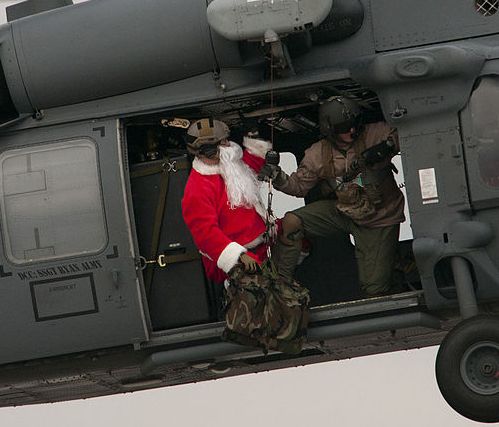 It’s not April Fools Day anymore, and the story I’m about to tell happened at a different time of year. But it is April for the next several days, so it’s still the best month to renew the tale of how a remote viewing prank caused the famous Ed Dames to turn Santa Claus into a terrorist. Some of you readers know the story from my book Reading the Enemy’s Mind. But there is a point to be learned that is as important today as it was more than 30 years ago when the story originally happened.
It’s not April Fools Day anymore, and the story I’m about to tell happened at a different time of year. But it is April for the next several days, so it’s still the best month to renew the tale of how a remote viewing prank caused the famous Ed Dames to turn Santa Claus into a terrorist. Some of you readers know the story from my book Reading the Enemy’s Mind. But there is a point to be learned that is as important today as it was more than 30 years ago when the story originally happened.
It was just before Christmas,1987. Skip Atwater, founder of the Army’s remote viewing unit and for ten years its operations and training officer was retiring. Ed Dames, who since his arrival in the unit had been Atwater’s assistant was now preparing to fill the vacuum.
Unfortunately, Ed had some questionable habits. He loved to use UFO events or extra-terrestrial topics for the practice sessions we viewers were expected to do. Since remote viewers have to be blind to the nature and identity of the target, that meant we trusted those tasking us to give us legitimate targets. And these “anomaly” targets weren’t legitimate because there was no ground-truth feedback available with which to compare our results.
We needed practice targets so we could hone our skills. Feedback is essential to learn or improve remote viewing ability. But operational RV projects (that is, real-world missions) often gave us no feedback due to secrecy concerns or other reasons. So we were supposed to do practice targets that did have feedback to reinforce learning. Feedback also serves as a reward by giving closure to the viewer at the end of a session. Not having that closure can be frustrating and emotionally draining. After working hard on operational projects, we craved sessions with real feedback for the closure that brought. Interesting as they might be, Ed’s UFO and ET targets deprived us of both benefits.
Another of Ed’s tendencies was to draw elaborate conclusions based on insufficient information. He would often embroider complex end-of-the-world, catastrophe, or terrorist-type scenarios, or fanciful accounts of extraterrestrial civilizations based on his own esoteric readings, combined with material he got from the anomaly sessions he tricked us into doing.
Finally, he would often engage far too enthusiastically in a session he was supposed to be monitoring. Even in double-blind sessions where he himself knew nothing about the target, he would often form a conclusion about what he thought the target was, and through suggestive language and questioning try to “lead” the viewer in that direction.
He became increasingly bold with this over time. The breaking point came when viewer Gabrielle (“Gabi”) Pettingell became so annoyed with Ed’s “leading” that she decided to do something about it. She and viewer Mel Riley hatched a plan. With our new boss, Lt. Col. Xenakis presiding, we met together while Ed was away. The plan was simple. We would pretend to remote view Santa Claus. Xenakis would create a fake tasking. This would be passed along to Dames, who would then unwittingly monitor sessions with each of us, and we would simply “report” things that were true about the fictional character Santa Claus, but phrased the way a remote viewer would.
It would run as a straightforward remote viewing project, different only in that the target was imaginary, and instead of being fully blind we would all know from the beginning what the target was. As I recall all five or six of the viewers assigned to the unit at the time participated.
In summary, some of us “perceived” that the main person involved was stealthy, active only at night. Others reported that the activity involved undocumented crossing of international borders, transporting packages and other items without going through customs. The payload was hidden in a large sack transported in an open-topped conveyance.
The suspect would come from the north, and some sort of flying would be necessary. The intended activity focused on a significant holiday or anniversary. In the pending “operation” the culprit would swoop down on sleeping families during the hours of darkness. Domesticated draft animals would somehow be involved. Still in training, Gabi simply produced a sketch of a sleigh runner. Of course, sleigh runners look pretty much like the landing skids of a variety of civilian or military aircraft.

Ed’s excitement increased with every session. He figured we were on to something big, and he was trying to get a handle on it. Finally, he thought he had it figured out. There was going to be a terrorist attack somewhere on American soil before the new year. One main terrorist was in charge, supported by a group of fanatical supporters, many of whom happened to be quite short. The perpetrator would be disguised with a beard and would infiltrate from the north, passing through sparsely populated areas using beasts of burden to carry his materials. He would put together an ultra-light aircraft and use it to cross the Canadian border.

Mel Riley was the final viewer. As he wrapped up, Ed headed out the door to rush the results to Xenakis and find a secure phone to pass his conclusions on to headquarters. But as he entered the hall, Ed could hear Xenakis chuckling from the monitoring room. Ed was no dummy, and he quickly realized he had been hoodwinked.
We all enjoyed ribbing Ed about it, and he took it good-naturedly. In commemoration, Gabi started a needle-point of Santa in an ultra-light to give to Ed, but could never get the pattern right. Amusing as it is, this story shows what can happen when remote viewing judges or analysts allow their personal biases to interfere. The “Great Santa Clause Caper” was artificially constructed. Yet I have seen the same mistakes duplicated in real RV projects done today.
Most of you already know that viewers must always be alert while remote viewing to avoid allowing preconceptions or biases to distort their perceptions. This holds true even after the remote viewing is done. When viewers compare their results to actual targets there is a strong temptation to interpret the results as more closely matching the actual target than they actually do. This is called “confirmation bias,” and must be eradicated from a viewer’s inventory of bad habits.
But what many of you don’t realize is that this isn’t just a problem for viewers. Project managers, judges, and analysts also fall prey to confirmation bias. It can be even more dangerous in that setting. If the project is “operational” (that is, addressing a real-world problem), decisions may be made and actions taken based on what could turn out to be conclusions skewed by a project manager’s confirmation bias. Even if the remote viewing is impeccably done, the judge might unconsciously or even intentionally favor or exaggerate some results while downplaying or dismissing other data to make final conclusions fit what he or she expected all along.
In a training setting, where the manager or tasker knows ground truth about the target, this is less problematic. But in an operational setting where there are many unknowns, it can bring catastrophe. Sometimes project managers think they can to do double duty as analysts. Too often they are wrong, since most of the time people don’t even recognize their biases and preconceptions. In those cases where it is unavoidable, they need to mercilessly root out their biases and preconceptions. But when possible it is always better to involve a competent, neutral third-party analyst. If you can do that, you will find it much easier to avoid turning Santa Claus into a hang-gliding terrorist with a bag full of bombs.
(Featured image courtesy US Army.)